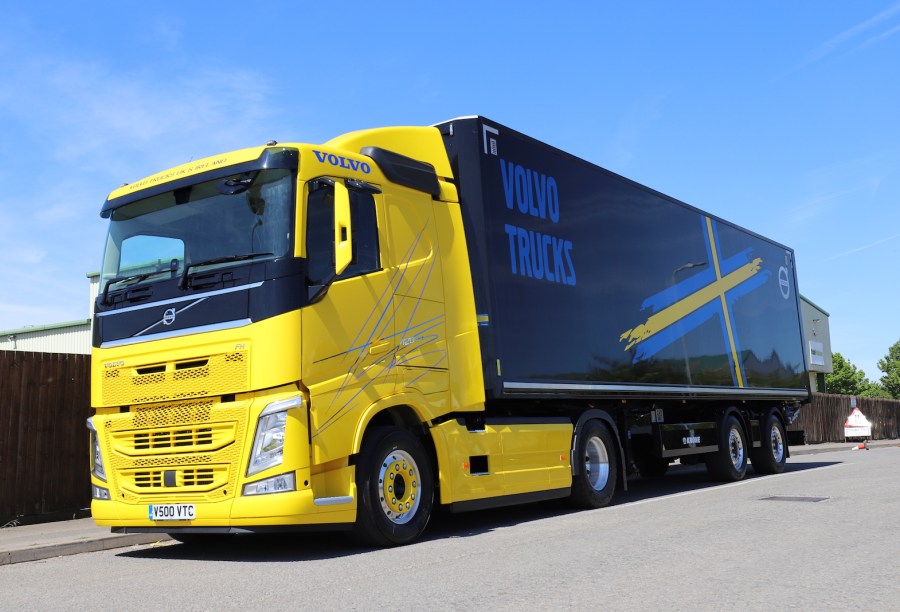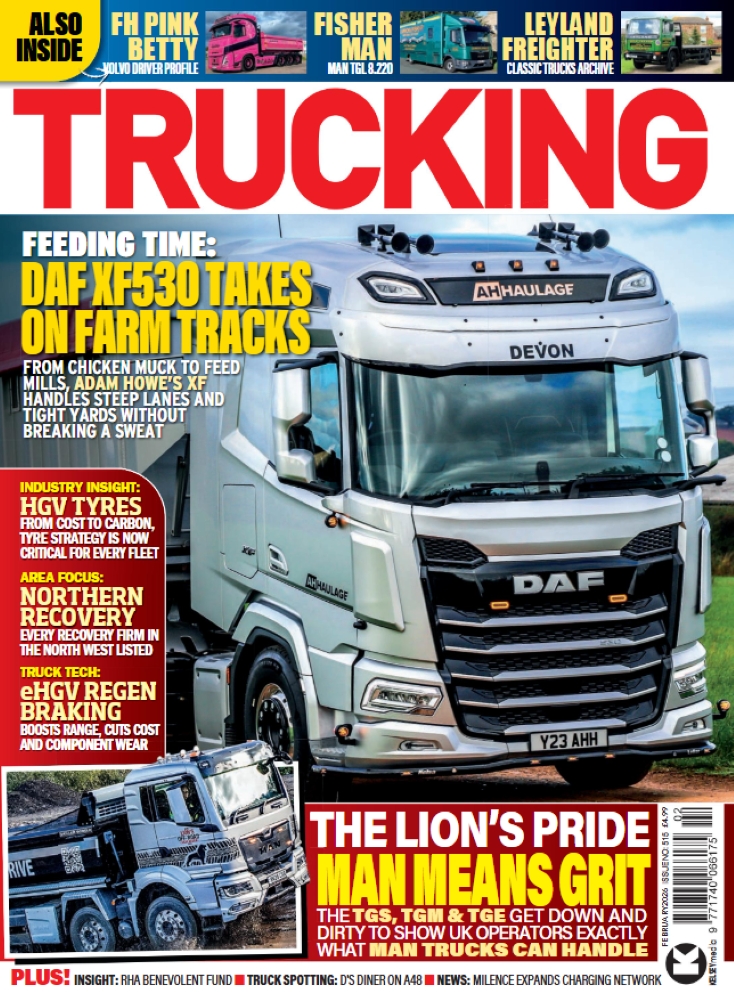Can you make a case for a Volvo FH13 as a 4×2 tractor for 32-tonne work? We need a bit of convincing that the sums will stack up and it truly is the right truck…
With Volvo having finally unveiled its new FM range, we’d normally have been champing at the bit to get our hands on the new distribution truck for a lengthy drive. But yes, you’ve guessed it: the coronavirus pandemic has put paid to that for the time being.
With all road testing currently still on hold and us hacks confined to barracks, it seems a good opportunity to look at another option. Volvo has recent been plugging for the 28/32-tonne four-axle urban delivery solution – the FH as a 4×2 flat-roof sleeper with the smallest output of its DK13 12.8-litre engine at 420 bhp.
So this Driven is strange, because this is a truck we have to admit has left us scratching our heads at, wondering what exactly it is for. Yes, it will do the job, and very well at that, but deep down we have reservations about it being the solution many hauliers will actually want.
The way we see it is, this truck sits between two clear solutions. The ‘worry about the resale’ operator who specs a high-roof 6×2 regardless of whether they actually need it, purely so it has a better resale value and an easier sell on. Or the ‘this is the truck I actually need’ operator who is more concerned more about their own operational requirements and not someone else’s later on down the line.
For the former, they really want an FH with the 460 or 500 bhp engine and a mid-lift – be it standard size or small wheel. For the latter, they really need a simple FM with the 11-litre engine at 410 or possibly 450 bhp, and with a basic single-bunk sleeper.
But this FH sits smack in between. It neither has the sell-on appeal of the bigger FH, nor the lighter weight and cheaper price of the FM. It’s hard to see what the market for a flat-roof FH13 4×2 tractor will be, especially when compared with the other types of trucks mentioned.
Technical overview
This FH – which Volvo calls a ‘Fuel Saver’ fleet-only tractor – has a single sleeper cab and the specification is clearly aimed at urban distribution and supermarkets.
We’ve often queried why Volvo has never offered its 11-litre engine in the FH range, and let’s face it, this truck would have been perfect with lighter engine at 410 bhp. But it’s not an option and we doubt it ever will be.
So the truck has the lowest powered variant of the D13K engine. Volvo is not as flexible as Scania in offering more choice in its range, and it doesn’t yet build the exact truck the customer wants. But that is its choice, and no amount of ‘comments’ from magazine testers is likely to change that any time soon.
V500 VTC is most definitely a bread-and-butter, no-frills truck, despite its striking yellow livery. It’s a simple 4×2 tractor with a flat roof and that single bunk – which may never be slept in other than for power naps by drivers bored rigid when stuck at an RDC, waiting to get unloaded or loaded.
Under the cab is the 420 bhp D13K engine which delivers those 420 horses at 1400-1800 rpm and offers a maximum of 2100 Nm of torque between 860-1400 rpm. The gearbox is Volvo’s popular and user-friendly AT2612F I-Shift 12-speed. The gear selector is buttons on the dash, which is a cleaner solution unlike the majority of FHs which had the gear ‘lever’ the left of the driver’s seat in the traditional position.
The wheelbase is 3700 mm on the medium-height chassis, and the truck has parabolic front suspension and air suspension on the rear, with an RSS1344D rear axle and a ratio of 2.47:1. Tyres on the front are 385/55R22.5 Michelin X Line Energy, with the similar 315/70R22.5 on the rear. Front axle capacity is 7.5 tonnes with a drive axle capacity of 11.5 tonnes.
Inside the cab is the basic cloth upholstery and a 33-litre under-bunk refrigerator – a nice extra even for a distribution truck. Media Pack with Navigation and Active Safety are both fitted, but the Visibility Package option has not been included. The fuel tank has a 405-litre capacity, while the AdBlue tank can hold 64 litres. A Jost air-operated sliding fifth wheel is fitted.
On the road
Although well capable of operating at 40 tonnes, that is not the market Volvo is pitching this truck at and accordingly it has the Volvo press fleet’s two-axle, rear-steer Krone trailer – again a perfect spec for town deliveries – giving a maximum gross weight of 32 tonnes.
Nowadays 400-450 bhp is a common power output, even for 28-tonne urban artics – you see many DAF CF410s, Scania P or G410s, Mercedes-Benz 1843s and their ilk on this work, so under the cab the FH is pretty much a match for any of them.
On the road, the FH certainly delivered as you’d expect. It has power to spare and handles exceptionally well indeed. It was a very relaxing drive. Unlike other FHs we have driven of late, we just had to take this motor for some town running – and with the rear-steer on the short 33 ft trailer, it is an exceptionally manoeuvrable outfit. The rise of the high street mini-marts as part of the portfolios of the big supermarket chains (hell, why don’t we just say Tesco metros?) sees many of these establishments served by artics. We are reluctant to call it an ‘urban artic’, as that conjours up images of draymen’s trucks – but we guess that’s probably the best description!
Town running also means there’s a lot more stop-start and a greater need to be ready for a brake application when someone – apparently oblivious to a bright yellow and black truck – simply walks out in front of you. The Active Safety feature is good in this respect.
Being high up has its advantages in terms of a better view of the road head when driving; but being lower down, as you would be in an FM, has a better sighting of the hazards that are more commonplace in towns: ie, people. Again, bearing that in mind, the FH seems to be a little over-specified.
Verdict
This was definitely an enjoyable truck to drive, and we agree the bigger cab makes it a better place for the driver to rest in than an FM when on their 45-minute compulsory break, or when held up for longer. But the fact remains the work this kind of vehicle will do is unlikely to include many, if indeed any nights out. Although we guess it’s nice to know a bunk is there should you want a nap, or just for the extra room to put your bags and stuff.
Also, we also agree day cabs have few advantages even for this work, and sleeper cabs offer many other bonuses. Most of all, they are easier to sell on; but also if a new job comes your way where a sleeper is needed, then you have it. And as the coronavirus has highlighted, if your regular ‘day only’ work dries up and you need to diversify, you already have a sleeper should replacement work necessitate it. Finally, if your driver were to be stranded, say due to bad weather or any other reason, they have the chance to at least bed down until it’s clear to crack on. Yes, we are a big fan of sleepers for any artic.
As nice as the FH on test here is, the question is would you really want an FH for town distribution? Having three steps and a higher cab floor makes it more of a hassle to get in and out, which may become a bit annoying after a while.
The FH is also more than likely to cost more compared with an FM, and it has an obvious weight penalty over the smaller model. We would argue for 28/32-tonne town deliveries, an FM is much better and even an FM Globetrotter would be better for the driver than a flat-roof FH.
The residuals might be better for the FH, but there will probably be less of a queue to buy it compared with an FM. An even then, overall TCO might still favour the smaller truck.
But they say there’s a driver shortage and a bigger cab will woo more drivers. In this market, we don’t really buy that argument – the best way to woo drivers is via their paypacket.
In short then, there’s nothing at all wrong with this FH. It’s a great truck and it will do a great job, and your drivers should like it. But we think there are better products in the Volvo portfolio for 28/32-tonne inner-urban distribution, and if we were ordering tractor units for this kind of operation, we’d be looking at the FM – or the CF, G-series, TGS, Hi-Way (or whatever Iveco calls its replacement) and so on.
In conclusion, the FH in this guise is a nice truck, but the wrong spec.
Likes:
- Volvo build quality
- Plenty of power
- Roomy cab
- Good dash
Dislikes
- An FM would be a better spec
- Resale options limited






